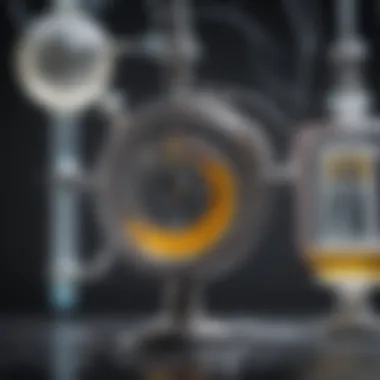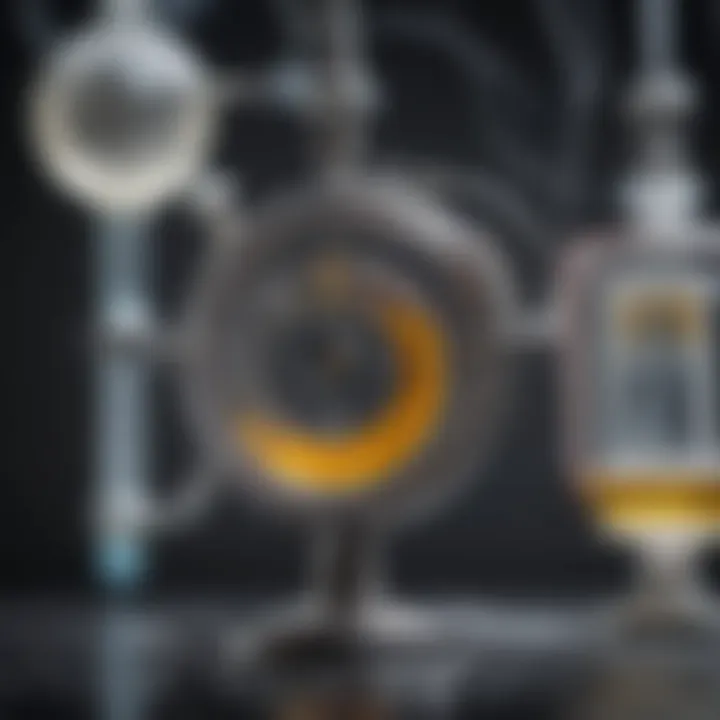Exploring the Chemistry of Sodium and Chlorine


Overview of Research Topic
Brief Background and Context
Sodium and chlorine are two fundamental elements that occupy unique positions in the periodic table. Sodium, a highly reactive alkali metal, is located in group one, while chlorine, a halogen, can be found in group seventeen. Their chemical properties reflect stark differences, yet their interaction leads to the formation of sodium chloride, commonly known as table salt. This relationship is not only of academic interest but also has notable implications in both natural and industrial contexts.
The creation of sodium chloride occurs through an ionic bond, where sodium donates an electron to chlorine. This electron transfer results in a stable compound crucial for various biological processes and industrial applications. Understanding their individual characteristics and the dynamics of their reaction fosters a deeper comprehension of essential chemical principles.
Importance in Current Scientific Landscape
In an era where the understanding of basic chemical processes is vital, comprehending the nuanc of sodium and chlorine's interaction is foundational. Sodium chloride is not merely a seasoning. It plays a pivotal role in numerous applications such as food preservation, chemical manufacturing, and even in medical uses like electrolyte balance in the human body. As issues such as water purification and renewable energy sources rise in importance, the roles of components like sodium and chlorine become even more pertinent.
Methodology
Research Design and Approach
This exploration employs a qualitative approach. It synthesizes existing literature, encompassing scholarly articles, reviews, and case studies focused on the chemistry of sodium and chlorine. By examining various sources, a holistic picture of their relationship is formed, shedding light on both theoretical and practical applications.
Data Collection Techniques
Data was acquired from reliable academic databases and journals, including reports from leading chemistry organizations. Online platforms such as en.wikipedia.org and britannica.com provided foundational knowledge. Each source was critiqued for its contribution to understanding the topic while emphasizing peer-reviewed articles for accuracy.
Sodium chloride is fundamental in both culinary and scientific fields, reflecting its versatile nature in various applications.
Through diligent research, this article aims to illuminate not only the chemistries of these elements but also their widespread impacts.
Preface to Sodium and Chlorine
Sodium and chlorine are elements that play a vital role in a variety of chemical and biological processes. Understanding their properties, interactions, and significance can enhance our grasp of both fundamental chemistry and practical applications. Sodium, an alkali metal, is known for its reactive nature, while chlorine, a halogen, exhibits unique characteristics that make it essential in several fields. Together, they form sodium chloride, commonly known as table salt, which serves as a key compound in numerous industries and biological functions.
This article aims to explore the essential properties of sodium and chlorine individually before examining their interactions that lead to the formation of sodium chloride. By diving into aspects such as their basic properties, chemical reactivity, and natural occurrences, we can identify the critical roles they play in our environment.
Basic Properties of Sodium
Physical characteristics
Sodium is characterized by its soft, silvery-white appearance that is a hallmark of alkali metals. This metal is highly malleable and ductile, which allows it to be easily shaped without breaking. At room temperature, sodium along with potassium is one of the least dense metals, making it float on water. This physical property is essential since sodium reacts vigorously with water, highlighting the element's unique characteristics. Its low density and the capability to conduct heat and electricity make it a fascinating subject for study.
Chemical behavior
The chemical behavior of sodium is marked by its strong reactivity, particularly with elements such as chlorine and oxygen. It readily donates one electron to form a positive ion (Na+). This property is crucial because it underpins sodium’s ability to form various compounds, including sodium chloride. Sodium's ease of oxidation and propensity to engage in reactions is a significant factor that not only defines its chemistry but also has widespread implications for chemical manufacturing and energy storage.
Occurrence in nature
Sodium does not occur freely in nature due to its highly reactive nature. Instead, it is predominantly found as sodium ions in various minerals and salts, most notably in seawater and rock salt. This natural occurrence highlights sodium's relevance in environmental chemistry and its implications in ecosystems. Further, understanding where and how sodium exists in nature helps in evaluating its extraction and utilization in industries.
Basic Properties of Chlorine
Physical characteristics
Chlorine is a greenish-yellow gas at room temperature and has a distinct, pungent odor. As a non-metal, it exists in a diatomic state (Cl2) and exhibits a substantial density relative to air. Chlorine is a strong oxidizing agent and can easily react with many elements, showcasing its potent chemical nature. This unique characteristic plays a significant role in its applications, especially in the production of disinfectants and bleach, where its reactivity is harnessed for cleaning and sanitization.
Chemical behavior
Chlorine’s chemical behavior is defined by its ability to form covalent bonds by gaining an electron to complete its outer orbital shell, thereby forming negative ions (Cl-). This property is critical, as it allows chlorine to bond with a variety of elements, leading to the development of a multitude of compounds. This reactivity makes chlorine indispensable in chemical industries, especially in water treatment and organic synthesis.
Occurrence in nature
Chlorine is found naturally in the form of salts in seawater, as sodium chloride, and in minerals. These occurrences are vital because they represent how chlorine is often harvested for industrial applications. This natural abundance indicates its ecological significance while also implying that its synthesis is often unnecessary for many applications. Understanding chlorine's presence in nature aids in implementing sustainable practices in its extraction and use.
The Reaction Mechanism of Sodium and Chlorine
The interaction between sodium and chlorine represents a fundamental chemical process that serves as a benchmark for understanding ionic bonding. This section outlines the importance of how sodium and chlorine react to form sodium chloride, a compound whose applications permeate various domains, from industrial to biological contexts. Understanding the mechanism behind this reaction contributes to a broader comprehension of chemical interactions and their implications.
Understanding Ionic Bonding


Electron transfer process
The essence of the electron transfer process can be observed when sodium reacts with chlorine. Sodium possesses one electron in its outer shell, which it tends to lose easily. On the other hand, chlorine, with seven electrons in its outer shell, seeks one more to achieve stability. The act of sodium donating its electron to chlorine establishes an ionic bond that is characterized by the resulting attraction between positively charged sodium ions and negatively charged chloride ions. This electron transfer is crucial because it creates the basis for chemical stability, making ionic compounds, like sodium chloride, less reactive than their constituent elements.
A key characteristic of this process is its high efficiency. Through a simple transfer, the involved elements reach a stable electronic configuration. This trait is beneficial as it simplifies understanding how similar reactions may occur with other alkali metals and halogens. The main advantage of the electron transfer process is its predictability and reliability in forming stable ionic compounds, which is pivotal for students and researchers alike when analyzing elemental interactions.
Formation of ions
The formation of ions is a direct outcome of the electron transfer process. When sodium loses its single outer electron, it transforms into a sodium ion. This ion is positively charged, denoted as Na⁺. Conversely, when chlorine receives this electron, it becomes a chloride ion, with a negative charge, represented as Cl⁻. The formation of these ions is fundamental for the development of ionic compounds like sodium chloride.
A significant aspect of ion formation is that it facilitates the arrangement of matter into a structured form. This structure allows various applications, from industrial synthesis to biological functions. The charged nature of the ions leads to the formation of electrostatic attractions, which is a core concept in chemistry and physics. While the formation of ions is advantageous for bond formation, it introduces considerations regarding the stability of ions in differing environments.
Formation of Sodium Chloride
Equation of the reaction
The equation representing the reaction between sodium and chlorine can be articulated as follows:
[ 2Na + Cl_2 \rightarrow 2NaCl ]
This equation elegantly conveys the transformation occurring during the reaction, highlighting the stoichiometry involved. This equation's clarity is vital to understanding how two moles of sodium react with one mole of chlorine gas to produce two moles of sodium chloride. This formulation aids in visualizing the relationship between reactants and products, essential for both educational and research purposes.
An important characteristic of this reaction equation is its balance. The conservation of mass is a pivotal principle that underscores chemical reactions; hence, the equation is advantageous for illustrating the fundamental laws of chemistry. It serves as a powerful teaching tool in classrooms, providing students with a straightforward understanding of fundamental chemical reactions.
Energy changes during the reaction
The energy changes that occur during the formation of sodium chloride are another crucial aspect of this reaction. The energy released when sodium and chlorine combine to form sodium chloride is substantial. This energy change is largely due to the strong ionic bonds that result from the attractive forces between the oppositely charged ions.
Understanding energy changes is imperative when studying chemical reactions. It provides insight into the exothermic nature of the reaction, helping students grasp why certain reactions occur spontaneously. A unique feature of the energy dynamics is the significant temperature increase observed during the reaction, which can sometimes ignite visible flames. The practical implications of energy changes in this context extend to fields such as thermodynamics, where they form the basis of energy management in chemical processes.
Understanding the reaction mechanism helps not just in grasping the bond formation but also in predicting the behavior of various compounds derived from sodium and chlorine.
Properties of Sodium Chloride
Sodium chloride, commonly known as table salt, is a compound of significant relevance in both chemistry and daily life. Its properties influence various scientific and industrial applications. Understanding these properties helps to appreciate sodium chloride's role in different contexts.
Chemical Composition
Molecular structure
The molecular structure of sodium chloride is straightforward yet significant. A sodium ion and a chloride ion bond together to form a neutral compound. The sodium ion carries a positive charge, while the chloride ion bears a negative charge. The arrangement of ions creates an ionic bond that is strong, enabling sodium chloride to maintain its integrity under normal conditions. This structure contributes to its stability and high melting point, typically around 801 °C. The crystalline nature is a key aspect, making it ideal for use in many applications such as seasoning, preserving food, and various chemical reactions. Its simplicity offers a direct way to explore ionic compounds and their interactions, making it a frequent subject in both educational and research settings.
Physical state at room temperature
In its physical state at room temperature, sodium chloride is a solid. It usually appears as white crystalline granules or coarse grains. This solid state is significant, as it shows how sodium chloride can be safely stored and transported. The solid form also enhances its use as a material for chemical reactions and food applications. Notably, sodium chloride's solubility in water allows it to dissociate into ions, making it effective in biological systems and various industrial processes. Its solid-state requires specific handling to avoid excessive exposure to moisture, which can lead to clumping and reduced efficacy in some uses.
Crystalline Structure
Lattice arrangement
The lattice arrangement of sodium chloride is a feature that underpins its properties. Sodium and chloride ions in a face-centered cubic lattice create a highly organized three-dimensional structure. This arrangement maximizes ionic bonding and stability within the crystal. Each sodium ion is surrounded by six chloride ions and vice versa, leading to a balanced and efficient structure. The distinct lattice structure also contributes to the hardness and high melting point of sodium chloride, making it advantageous for various applications such as de-icing roads and industrial cleaning mixtures. Its arrangement leaves minimal gaps for impurities, thus ensuring high purity in manufactured sodium chloride products.
Types of crystal systems
Sodium chloride crystallizes within the cubic crystal system, recognized for its symmetrical properties. This uniformity in structure leads to predictable behavior during physical changes, such as melting or dissolving. The cubic arrangement also emphasizes sodium chloride's strong ionic character, distinguishing it from other salt types which may present different crystalline systems. Understanding the cubic nature aids experts in predicting sodium chloride's behavior under varied conditions, essential for industries that depend on precise chemical reactions. Thus, sodium chloride’s crystal system provides vital insights into its practical uses in food production, pharmaceuticals, and chemical synthesis.
Applications of Sodium Chloride
Sodium chloride, commonly known as table salt, has a wide range of applications that are essential to both industrial processes and biological systems. Understanding these applications is crucial for grasping the significance of sodium chloride in various domains. The following sections will address its industrial uses as well as its role in biological systems. This exploration will highlight the benefits, unique aspects, and practical considerations related to sodium chloride in these contexts.
Industrial Uses
Chemical manufacturing
Chemical manufacturing relies heavily on sodium chloride for various processes. One key characteristic is its utility in producing several chemicals, such as sodium bicarbonate, chlorine gas, and sodium hydroxide. These chemicals serve crucial functions in multiple industries, from agriculture to water treatment. Sodium chloride is a viable choice for chemical manufacturing because it is abundant and relatively inexpensive.
- Unique Feature: Sodium chloride can be sourced easily from evaporation of seawater, making its availability a significant advantage.
- Advantages: The processes associated with sodium chloride are generally straightforward and economical. However, the environmental considerations regarding large-scale extraction should not be ignored.


Food preservation
Food preservation is another vital application of sodium chloride. This compound acts as a preservative by inhibiting the growth of bacteria and fungi. Its ability to dehydrate microorganisms helps extend the shelf life of many food items, including meats and vegetables. Sodium chloride is a popular choice in food preservation due to its effectiveness at relatively low concentrations.
- Unique Feature: The anti-microbial properties of sodium chloride enable it to maintain the quality and safety of food products.
- Advantages: While it is effective, over-reliance on sodium chloride can raise health concerns. It's essential to find a balance in its use, considering the risks of high sodium intake.
Role in Biological Systems
Importance in human physiology
The importance of sodium chloride in human physiology cannot be overstated. Essentially, it plays a crucial role in maintaining fluid balance, nerve transmission, and muscle function. Sodium, one of the two elements in sodium chloride, is vital for generating electrical impulses in the body. Its concentration is carefully regulated to ensure proper functioning of cellular processes.
- Unique Feature: Sodium's ability to conduct electrical signals makes it pivotal for nerve and muscle activity, essential for survival.
- Advantages: Understanding its function assists in managing health issues, including dehydration and imbalances that can lead to serious conditions.
Electrolyte Balance and Cellular Function
Sodium chloride contributes significantly to the electrolyte balance in the human body. Electrolytes are necessary for cellular function; they help regulate nerve and muscle function, hydration, blood pH, and blood pressure. Sodium ions are among the primary electrolytes found in body fluids. Proper electrolytic balance is crucial for overall health and well-being.
- Unique Feature: Sodium chloride's ionic nature helps maintain osmotic pressure, crucial for fluid distribution in cells.
- Advantages: An adequate understanding of electrolyte balance can optimize health and athletic performance. However, excessive sodium intake can lead to health risks, such as hypertension.
Sodium chloride's diverse applications illustrate its importance beyond just flavor enhancement in food. From industry to health, sodium chloride remains a fundamental compound.
Health Implications of Sodium Intake
Sodium intake is a topic of considerable relevance in discussions surrounding nutrition and public health. As a primary electrolyte in the human body, sodium plays a crucial role in various physiological processes, including fluid balance, muscle function, and nerve signaling. However, both insufficient and excessive sodium levels can lead to health complications. Understanding the implications of sodium intake is essential for promoting overall health and preventing related disorders.
Recommended Dietary Allowances
Daily sodium intake guidelines
The daily sodium intake guidelines suggest a maximum of 2,300 milligrams for most adults, which is roughly a teaspoon of salt. This recommendation stems from studies linking high sodium consumption to health issues. The key characteristic of these guidelines is their focus on reducing hypertension risk, which can arise from chronic high sodium intake. Following these guidelines is beneficial as it encourages individuals to monitor and moderate their sodium consumption.
A unique feature of the daily sodium intake recommendations is their adaptability to individual health conditions. For example, people with high blood pressure may benefit from a stricter limit of 1,500 milligrams. This tailored approach provides advantages for more vulnerable populations but may pose challenges for those unaccustomed to dietary restrictions.
Sources of dietary sodium
Sodium occurs naturally in various foods, but processed and packaged items often contain high levels. Key sources of dietary sodium include table salt, canned soups, snack foods, and prepackaged meals. Understanding these sources is vital for those attempting to regulate their sodium intake. Unprocessed foods, like fruits and vegetables, generally contain low sodium levels and are favorable choices for a balanced diet.
The unique feature of these sources is their availability and convenience, making it easy to consume. However, this also leads to the disadvantage of unwittingly exceeding the recommended limits. Being aware of sources enables individuals to make informed dietary choices, ultimately leading to improved health outcomes.
Consequences of Excess Sodium
Hypertension
Hypertension, or high blood pressure, is a significant consequence of excessive sodium intake. It is a prominent health concern, often characterized by elevated force against artery walls. The relationship between sodium and hypertension arises from sodium's ability to cause the body to retain water, increasing blood volume. A key characteristic of hypertension is its often asymptomatic nature, which can lead to delayed diagnosis and treatment.
Highlighting hypertension in discussions about sodium is crucial due to its prevalence as a risk factor for more severe health issues. Managing sodium intake can substantially reduce this risk, making it a practical focus for public health initiatives. However, changing dietary habits can require time and effort, presenting a potential disadvantage for some individuals.
Cardiovascular diseases
Excess sodium intake is also directly associated with various cardiovascular diseases. High blood pressure, often resulting from excessive sodium, increases the risk of heart attack and stroke. The key characteristic of cardiovascular diseases is their complexity, involving multiple risk factors, including lifestyle choices and genetic predisposition.
Focusing on cardiovascular diseases in relation to sodium intake is significant as it emphasizes the broader implications of dietary choices on heart health. The connection shows that reducing sodium can serve as a preventive measure for many. The challenge remains in motivating individuals to change long-standing habits, which can sometimes be difficult to navigate.
Understanding the balance of sodium intake is essential for maintaining health and preventing diseases related to cardiovascular health and hypertension.
Environmental Impact of Sodium and Chlorine
Understanding the environmental impact of sodium and chlorine is crucial in recognizing their roles in various ecological and industrial processes. Sodium and chlorine are not just individual elements but play significant roles as parts of compounds and in reactions that affect ecosystems and public health. Recognizing their advantages and limitations can lead to better practices in their use, contributing to a more sustainable future.
Chlorine in Water Treatment
Purification processes
Chlorine is widely utilized in water treatment as a purification agent. It effectively helps to eliminate bacteria, viruses, and other pathogens that can contaminate water supplies. The main advantage of using chlorine in this process is its strength and efficiency in killing harmful microorganisms. This makes it a popular choice among treatment facilities. While chlorine is effective, there are unique byproducts formed when it reacts with organic material in water, referred to as trihalomethanes. These byproducts can pose health risks if present in significant concentrations.
Safety concerns


Despite its benefits, the use of chlorine also raises safety concerns. Chlorine gas is toxic and can cause respiratory problems in high concentrations. This makes handling and storage critical. Proper training and safety equipment are required to mitigate risks associated with chlorine exposure. The potential for accidents, such as leaks or spills, is a consideration that treatment facilities must address. Therefore, while chlorine is an essential component in making water safe to drink, its risks cannot be overlooked.
Sodium's Role in Soil and Water
Effects on ecosystem health
Sodium plays a multifaceted role in soil and water dynamics. It is important for the health of plants as it helps regulate osmotic pressure. Nonetheless, excessive sodium can lead to soil salinization, which has detrimental effects on plant growth and soil structure. When sodium levels increase, it can adversely affect agricultural output and the overall health of ecosystems. Monitoring sodium levels is vital to prevent degradation of agricultural land and protect natural habitats.
Ionic balance in aquatic environments
Maintaining the ionic balance in aquatic environments is essential for the survival of aquatic life. Sodium ions, along with potassium and calcium ions, contribute to the overall ionic composition of water. This balance is crucial for osmoregulation in fish and other aquatic organisms. Disturbances to this balance can lead to stress or mortality among aquatic species. As human activities often contribute to changes in sodium levels, it is important to manage these inputs to maintain healthy aquatic ecosystems.
Research and Innovations
Research and innovations centered on sodium and chlorine are vital, as they advance the understanding and applications of these elements. These studies lead to enhanced methods and technologies that impact various fields, from environmental science to healthcare. Currently, researchers explore new techniques in chemical synthesis and investigate the potential future applications of sodium and chlorine compounds. This is important for several reasons.
- Improvement of Existing Methods: Advancements can refine traditional chemical processes, making them more efficient.
- Sustainability: Innovations contribute to the development of more sustainable practices in chemical manufacturing.
- Health and Safety: There is an increasing focus on how sodium and chlorine use can be modified for health benefits, reducing risks to human health.
Through rigorous research, scientists continue to discover new frontiers in the usage and understanding of sodium and chlorine.
Advancements in Chemical Synthesis
New methods in producing sodium compounds
The pursuit of new methods in producing sodium compounds is impressive. This branch of research focuses on creating sodium compounds using innovative techniques that lower energy consumption and improve yield. A key characteristic is the development of electrochemical processes. These processes are becoming a popular choice in both academia and industry due to their efficiency and reduced environmental impact.
The unique feature of this method is its ability to utilize renewable energy sources, which can significantly lower the carbon footprint compared to traditional methods. However, there are also disadvantages, such as the initial investment costs for technology and equipment.
Impact on sustainability
Impact on sustainability is a pivotal matter regarding sodium and chlorine research. Emphasis is placed on finding ways to minimize waste and improve resource efficiency. The key characteristic of sustainability in this context is the focus on circular economy principles. This is a beneficial approach for this article, as it relates to how sodium and chlorine can be used without exhausting resources.
A unique feature of these sustainable practices is the recycling of by-products from sodium and chlorine processes. While there are many advantages, including reduced environmental harm, challenges exist in ensuring economic feasibility for widespread adoption.
Future Directions in Sodium and Chlorine Research
Emerging applications
Emerging applications highlight the diverse ways sodium and chlorine research continues to evolve. New uses are being explored in areas like energy storage, water purification, and green chemistry. A notable benefit of focusing on these applications is their potential to solve pressing global issues.
The unique feature of these applications is their interdisciplinary nature, bringing together chemistry, biology, and environmental science. However, some limitations might arise from regulatory challenges and the need for further development prior to commercial viability.
Potential health discoveries
Potential health discoveries related to sodium and chlorine are crucial to their ongoing research. This includes understanding the biochemical pathways influenced by sodium and chlorine in human health. A key characteristic here is the relationship between sodium intake and various health outcomes, making this topic relevant for public health conversations.
The unique features of these discoveries can lead to significant advancements in personalized medicine. However, outcomes are still being studied, and conclusive guidelines may take time to develop.
Research and innovations concerning sodium and chlorine offer vast potential for advancements in science and technology, promising a more sustainable future for chemical applications.
Ending
In the context of the intricate relationship between sodium and chlorine, this article underscores the importance of understanding these two elements and their interactions. Sodium and chlorine are not just fundamental units of chemistry; they play vital roles in numerous aspects of both our environment and industrial applications. The synthesis of sodium chloride, commonly known as table salt, illustrates how two reactive elements can combine and produce a stable compound with extensive use in daily life.
The key points discussed highlight both the individual characteristics and the collective significance of these elements. Understanding the basic properties of sodium and chlorine helps to grasp their behavior in chemical reactions. Furthermore, recognizing the practical applications of sodium chloride—ranging from food preservation to its role in biological systems—emphasizes the broader relevance of these chemical elements in our lives.
In addition, the environmental implications of sodium and chlorine usage cannot be overlooked. The necessity for safe practices, especially in water treatment processes, reflects the growing awareness about the effects of these elements on ecosystem health.
"Sodium and chloride ions are essential for biological functions, yet must be managed wisely to protect health and environment."
In summary, discussions on sodium and chlorine reveal profound connections not only between chemistry and industry but also highlight considerations for health and environmental sustainability. This reinforces the need for ongoing research and innovation as we further explore their properties and functionalities in our ever-evolving world.
Summary of Key Points
- Sodium and chlorine are critical elements in chemistry that combine to form sodium chloride.
- Sodium chloride has essential applications in food preservation and human health.
- The environmental impact of sodium and chlorine usage must be carefully considered.
- Ongoing research will continue to unveil new insights and applications of these elements.
Future Perspectives on Sodium and Chlorine
Looking ahead, research into sodium and chlorine holds the promise of groundbreaking applications across various fields. Emerging research may focus on innovative methods for synthesizing sodium compounds more sustainably. Additionally, the potential discoveries related to health, especially regarding sodium intake, present opportunities for the advancement of dietary guidelines.
Moreover, as industries strive for greener alternatives, the role of sodium and chlorine in sustainable development will gain prominence. This includes exploring their uses in renewable energy solutions, agricultural practices, and environmental conservation efforts.
Overall, the future perspectives on sodium and chlorine suggest a pathway to harness their unique properties while maximizing benefits to both humanity and the planet.



